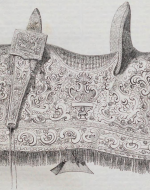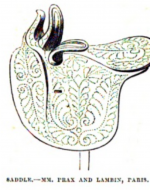Created by Leo VanderPoel on Thu, 02/13/2025 - 14:16
Description:
In our modern day, members of the upper class primarily participate in equestrian sports due to their expensive nature. However, this was not the case during the Victorian period, as horses were a key aspect of transportation in England as well as the world as a whole, even as trains came onto the scene in the 1840s. As such, equestrian equipment like saddles were still a key part of Victorian culture at the time of The Great Exhibition of 1851. However, not all saddles were made equally. The saddles in this exhibit are high quality with all three of them being embroidered and two brought from Tunisia to be displayed at the Great Exhibition. These saddles, much like most saddles in the modern era, would have been reserved for the elite and extremely wealthy. One of these saddles was even acquired by Queen Victoria herself. While there were statues of horses in the Crystal Palace, the saddles were displayed on saddle racks, as real horses were too skittish and messy to have inside.
Mock booth for Saddles at The Great Exhibition of 1851, designed by Leo VanderPoel, 2025. This booth mimicks one that might have been found at the Great Exhibition of 1851. The backdrop is a hand-drawing of a stable with two printed drawings of horses attached and a hand-drawn sign above that reads "SADDLES." There are three folded mini saddle racks with images of saddles attached to them glued to the floor of the booth. The sides of the booth are decorated with printed drawings of the Great Exhibition. All of the hand-drawn aspects were initially sketched in pencil and then inked with Micron pens and colored with alcohol markers.
"The Great Exhibition, 1851: Embroidered Saddle from Tunis," 1851, Hugh Owen, in Exhibition of the Works of Industry of All Nations, 1851: Reports by the Juries on the Subjects in the Thirty Classes into which the Exhibition was Divided, Volume III. This is a photograph on salted print paper of an embroidered saddle from Tunis as part of the display from Tunisia. It is finely enbroidered and has tassles attached. A bridle and other tack lie atop it, which are also embroidered.The photograph was taken by Hugh Owen, and Queen Victoria later acquired the saddle itself.
"Ornamented and Embroidered Tunisian Saddle." 1851, W. Clowes and Sons, in The Official Descriptive Catalogue of the Great Exhibition of the Works of Industry of all Nations, Class, Volume III, Class "Tunis," Foreign States, p. 1414. This illustration depicts a mule saddle from Tunisia without its stirrups. It is made of cloth and ornamented and with gold embroidery. It is notably more square in shape than English-style saddles and has a very high pommel and cantle. It is more reminiscent of western-style saddles with its more square shape.
"Saddle." MM [P]rax and Lambin, Paris," 1851, John Cassele, in "The Illustrated Exhibitor." This is a pen-and-pencil illustration of a sidesaddle from Paris that was displayed at the Great Exhibition of 1851. It has three horns and appears to be finely embroidered. A woman would have used this sidesaddle, as riding in such a way was thought to preserve a woman's modesty. It was also easier to ride side saddle while wearing a skirt. The designer added the leg support to reduce the fatigue women would experience from the awkward way they rode. Although it is acceptable for women to ride astride nowadays and they dominate equestrian sports, people (mostly women) still ride sidesaddle today, though it is far less common than riding astride.





